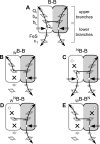Enzymatic activities of isolated cytochrome bc₁-like complexes containing fused cytochrome b subunits with asymmetrically inactivated segments of electron transfer chains
- PMID: 22233445
- PMCID: PMC3269193
- DOI: 10.1021/bi2016316
Enzymatic activities of isolated cytochrome bc₁-like complexes containing fused cytochrome b subunits with asymmetrically inactivated segments of electron transfer chains
Abstract
Homodimeric structure of cytochrome bc₁, a common component of biological energy conversion systems, builds in four catalytic quinone oxidation/reduction sites and four chains of cofactors (branches) that, connected by a centrally located bridge, form a symmetric H-shaped electron transfer system. The mechanism of operation of this complex system is under constant debate. Here, we report on isolation and enzymatic examination of cytochrome bc₁-like complexes containing fused cytochrome b subunits in which asymmetrically introduced mutations inactivated individual branches in various combinations. The structural asymmetry of those forms was confirmed spectroscopically. All the asymmetric forms corresponding to cytochrome bc₁ with partial or full inactivation of one monomer retain high enzymatic activity but at the same time show a decrease in the maximum turnover rate by a factor close to 2. This strongly supports the model assuming independent operation of monomers. The cross-inactivated form corresponding to cytochrome bc₁ with disabled complementary parts of each monomer retains the enzymatic activity at the level that, for the first time on isolated from membranes and purified to homogeneity preparations, demonstrates that intermonomer electron transfer through the bridge effectively sustains the enzymatic turnover. The results fully support the concept that electrons freely distribute between the four catalytic sites of a dimer and that any path connecting the catalytic sites on the opposite sides of the membrane is enzymatically competent. The possibility to examine enzymatic properties of isolated forms of asymmetric complexes constructed using the cytochrome b fusion system extends the array of tools available for investigating the engineering of dimeric cytochrome bc₁ from the mechanistic and physiological perspectives.
Figures




References
-
- Kramer D. M., Nitschke W., and Cooley J. W. (2009) The cytochrome bc1 and related bc complexes: the Rieske/cytochrome b complex as the functional core of a central electron/proton transfer complex, in The Purple Phototrophic Bacteria (Hunter N., Daldal F., Thurnauer M. C., and Beatty J. T., Eds.) Springer, The Netherlands.
-
- Crofts A. R.; Holland J. T.; Victoria D.; Kolling D. R. J.; Dikanov S. A.; Gilbreth R.; Lhee S.; Kuras R.; Guergova Kuras M. (2008) The Q-cycle reviewed: how well does a monomeric mechanism of the bc1 complex account for the function of a dimeric complex?. Biochim. Biophys. Acta 1777, 1001–1019. - PMC - PubMed
Publication types
MeSH terms
Substances
Grants and funding
LinkOut - more resources
Full Text Sources

